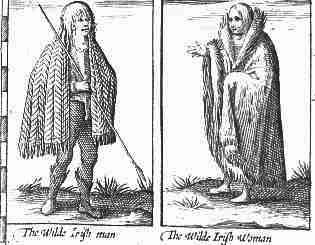Rural families
The vast majority of families in the three hundred years under consideration were peasants.
- At the most basic level were labouring families who worked for others in return for food and shelter.
- Farming families in a Gaelic tuath, by the age-old custom of gavelkind, had pieces of land apportioned to their male members for life and from time to time these portions were redistributed.
- Farmers in areas subject to English law leased land for a limited number of years and could be kept in line by the fear that their leases might not be renewed.
- A mixture of Gaelic and English land holding existed in some areas.
- Farm size varied and there were large, medium and small size farms under both systems.
The majority depended for land, security and protection on the aristocratic minority that was wealthy and powerful in both Gaelic and Old English societies alike. The aristrocacy in turn depended on their subjects for wealth and for troops in case of attack or
defence.
Subject families in Gaelic areas had to provide:
- fighting men when the chieftain demanded them
- coyne and livery, that is food, lodging - and wages sometimes - for the lord's soldiers, often accompanied by their dogs and horses
- 'cuttings' of cattle, oats, wheat, bread, butter, etc. to meet the lord's expenses.
A better off woman would bring a dowry to her marriage consisting of cows and other livestock as well as household items such as pans and equipment for dairying, brewing and cooking - often connected with the kind of work she would do or supervise in her new family.
Land owning families were displaced on a massive scale during the Plantation period but Gaelic surnames surviving in planted areas show that minor tenant and labouring families mostly remained where they were, though with different landlords and employers.
'The Wilde Irish'
This is how John Speed depicted rural Irish people in the early 17th century
Questions
- Farming families in a Gaelic ____, by the the age-old custom of ____, had pieces of land apportioned to their ____ members for life and from time to time these ___ were _____.
- The majority _________ on the aristocratic ______ minority that was wealthy and ____ in both Gaelic and ____ _____ societies alike.
- How might a woman in Gaelic Ireland be affected by: gavelkind; coyne and livery; cuttings?
Activities
- Describe a day in the life of a poor woman in a Gaelic tuath in early modern Ireland.
- Write a letter from a poor Gaelic woman to her chieftain, complaining about the problems of women in her tuath.
- Study the extract 'Sir John Davies' in Documents at the end of this section.

